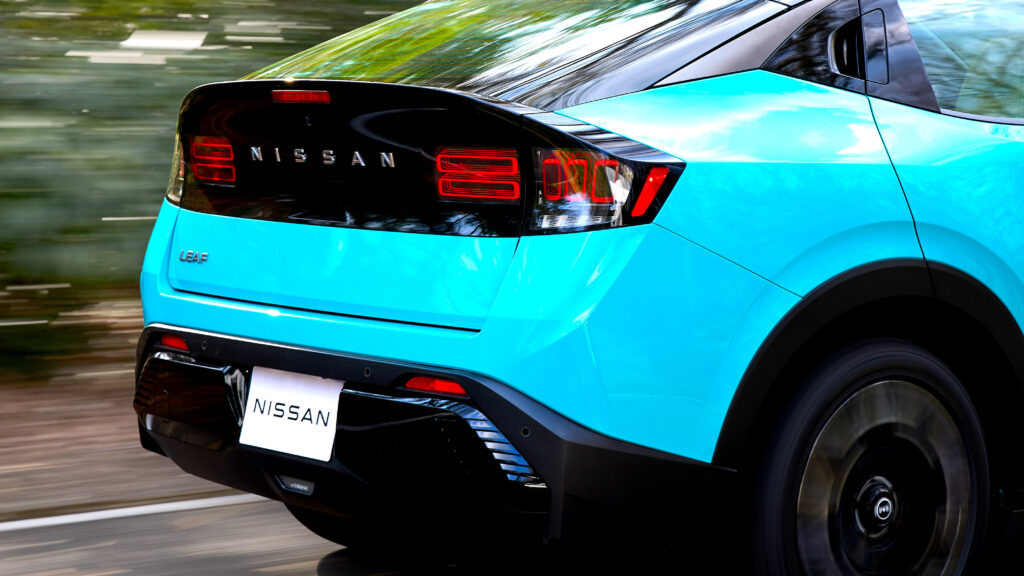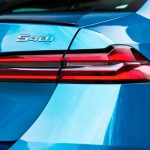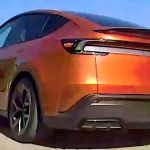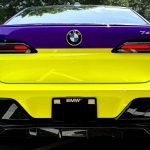

- The third-generation Leaf arrives with fastback crossover styling and new tech.
- The EV is Nissan’s most aerodynamic model yet thanks to its clever design.
- It produces up to 214 hp and has a maximum range of 303 miles (488 km).
Electric cars are evolving fast, and Nissan wants the next Leaf to prove it still has a place in the conversation. The company has finally unveiled the next-generation of what many consider to be the world’s first mass market EV promising to match the convenience of an ICE-powered vehicle.
var adpushup = window.adpushup = window.adpushup || {que:[]};
adpushup.que.push(function() {
if (adpushup.config.platform !== “DESKTOP”){
adpushup.triggerAd(“0f7e3106-c4d6-4db4-8135-c508879a76f8”);
} else {
adpushup.triggerAd(“82503191-e1d1-435a-874f-9c78a2a54a2f”);
}
});
More: Here’s What’s Coming To The 2026 Nissan Rogue
The new Leaf trades the the familiar hatchback shape of past models for a crossover profile, complete with a fastback-style rear. Key design elements up front include sharper LED headlights flanking a body-colored panel and an active grille shutter that adjusts to optimize airflow.
New Shape, Familiar DNA
Viewed from the side, the new Leaf draws a little inspiration from the Tesla Model Y, though it carves out its own identity with more sculpted lines and a bolder stance. Wheel sizes range from 18 to 19 inches, with a modern, angular design. The front doors get flush-mounted handles, while the rear handles are tucked into the C-pillars. Finally, the sporty tail with an integrated spoiler and dark-tinted taillights is reminiscent of the Nissan Z.
While slightly smaller overall than its predecessor, the latest Leaf is more aerodynamically efficient. The EV has a 2,690 mm (105.9 inches) wheelbase and measures between 4,350-4,405 mm (171.3-173.4 inches) long depending on the region. Nissan claims it’s their most aerodynamic production vehicle to date, with a drag coefficient of 0.25 in Europe and 0.26 in the US and Japan.
The small differences come down to things like wheels and mirrors, which are tweaked depending on the market. In the US, amber indicators in the wheel arches set the model apart.
Minimalist Cabin, Modern Tech
var adpushup = window.adpushup = window.adpushup || {que:[]};
adpushup.que.push(function() {
if (adpushup.config.platform !== “DESKTOP”){
adpushup.triggerAd(“bb7964e9-07de-4b06-a83e-ead35079d53c”);
} else {
adpushup.triggerAd(“9b1169d9-7a89-4971-a77f-1397f7588751”);
}
});
Moving inside, Nissan opted for a minimalist layout, following the latest trends. The digital cockpit comprises dual 12.3-inch or 14.3-inch displays depending on the trim and region. The new screens are joined by a two-spoke steering wheel with integrated controls, touch-sensitive shortcuts on the dashboard, and buttons instead of a traditional gear shifter.
More: Mitsubishi’s American EV Will Be A Nissan In Disguise
Another highlight is the optional panoramic roof with an e-Dimming function. The later uses electrochromic technology and an infrared reflective coating, eliminating the need for a physical sunshade. High-spec models get a Bose Personal Plus audio system with additional speakers mounted on the front headrests.
The new generation also benefits from more sophisticated ADAS, including a 3D Intelligent Around View Monitor, Invisible Hood View and Front Wide View functionality. Select regions will also gain access to the new Intelligent Distance Control Assist for city driving.
var adpushup = window.adpushup = window.adpushup || {que:[]};
adpushup.que.push(function() {
if (adpushup.config.platform !== “DESKTOP”){
adpushup.triggerAd(“b25ecba7-3bbb-4ea7-a3a8-dbea91695c07”);
} else {
adpushup.triggerAd(“e46c436a-adeb-4b5e-a2c7-56bc36561c10”);
}
});
Despite having a smaller footprint compared to its predecessor, Nissan says that the new Leaf offers a spacious cabin designed for the needs of a modern family. The boot has a capacity of 437 lt (15.4 cubic feet) in Europe and 420 lt (14.8 cubic feet) in the US.
FWD-Only Layout, Two Battery Options
Underneath, the Leaf shares its CMF-EV platform with the larger Ariya, which means a flat floor and a roomier cabin layout. However, unlike its bigger cousin, the Leaf is exclusively available with a single electric motor moving the front wheels. This motor is said to be 75% quieter and 10% smaller than before.
The entry-level version has a 52 kWh battery and an output of 174 hp (130 kW / 176 PS) and 345 Nm (254 lb-ft) of torque which is higher compared to its predecessor. The flagship trim upgrades to a larger 75 kWh battery and a stronger electric motor generating 214 hp (160 kW / 218 PS) and 355 Nm (262 lb-ft).
Nissan promises a longer range of up to 303 miles (488 km) for the bigger battery option, with fast-charging capability that can add 250 km (155 miles) in just 14 minutes. According to the company, this matches the average time that ICE-powered vehicle owners spend at gas stations, making the experience of owning an EV less of a burden. Furthermore, when connected to an 150 kW DC charge, the battery can replenish 10-80% of its charge in 35 minutes.
Overall, Nissan claims that the EV can compete an 800 km (500-mile) trip with “minimal time difference” to an ICE vehicle. As for the more optimistic range estimates in the WLTP cycle, those are 436 km (271 miles) for the 52 kWh battery and up to 604 km (375 miles) for the 75 kWh battery.
Charging Ports for Every Market
The US-spec Leaf gains a NACS-compatible charging port, providing access to the Tesla Supercharger network. Still, Japanese models will retain the CHAdeMO port and the European version keeps the traditional CCS port.
The liquid-cooled battery of the new generation is also equipped with a navigation-linked conditioning system, and an enhanced thermal recovery and management system for improved efficiency. The EV also comes with vehicle-to-home and vehicle-to-load capability depending on the region.
More: Nissan’s New Hybrid System Promises EV-Like Benefits But At A Cost
Nissan also highlighted the new multi-link rear suspension, the improved maneuverability, and a 66% increase in lateral rigidity compared to the previous generation.
Richard Candler, Nissan’s vice president of global product strategy, says the goal was to make the new Leaf a real contender for buyers used to gas-powered vehicles. That meant designing a sleeker body without giving up on practicality, and ensuring long-distance driving was part of the deal.
Availability
The 2026 Nissan Leaf is set to arrive at US dealerships this autumn, with a gradual rollout to follow in other markets. In Europe, orders will begin this autumn with the first deliveries expected in spring 2026. Pricing details for each market will be shared closer to launch. Production will take place at Nissan’s Tochigi plant in Japan and the Sunderland facility in the UK.
Since its debut in 2010, Nissan says it has sold nearly 700,000 Leafs worldwide, using feedback from longtime owners to help shape the next generation.




